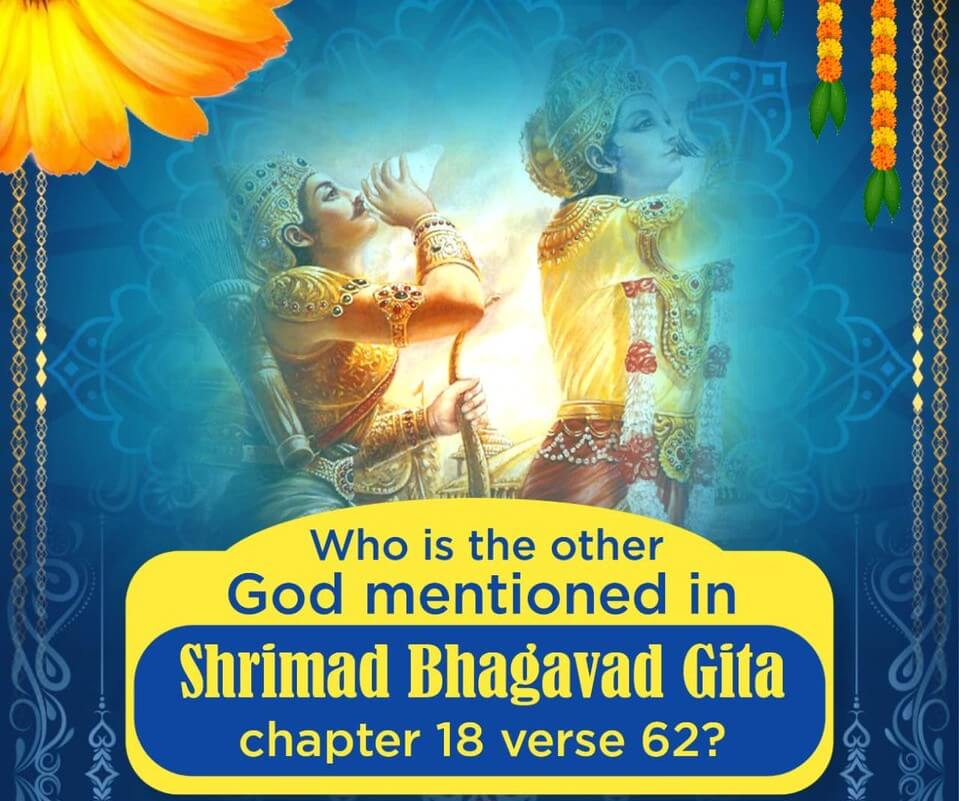The Hidden Gist of Bhagavad Gita: A Call to Seek the Supreme God Beyond the Gita Speaker
The Bhagavad Gita, revered as a sacred scripture of Hinduism, is a divine dialogue between Lord Krishna and Arjuna on the battlefield of Kurukshetra. While many interpret the Gita as a message to surrender to Krishna alone, a deeper reading—particularly of Chapter 18, Verses 62 to 66—reveals a profound truth: the speaker of the Gita himself directs the seeker to surrender to a Supreme God greater than himself for attaining complete liberation.
The Pivotal Verses: Bhagavad Gita 18:62–66
Let us closely examine the verses that hold this hidden gem of divine knowledge:
Bhagavad Gita 18:62
“Tam eva sharanam gachha sarva-bhavena bharata, tat-prasadat param shantim sthanam prapsyasi shashvatam.”
Translation: "O Bharat (Arjuna), go in every respect to the shelter of that Supreme God. By His grace, you will attain supreme peace and the eternal abode."
Here, the Gita speaker—Kaal Brahm inside Lord Krishna—clearly instructs Arjuna to go to another God. The words “tam eva” (to that God) indicate that the refuge advised is not the speaker himself, but a higher, Supreme God.
Bhagavad Gita 18:63–65
In these verses, the speaker allows Arjuna the free will to reflect and choose:
“I have imparted the most confidential knowledge. Ponder over it fully and do as you wish.”
He then says:
“Fix your mind on me, become my devotee…”—offering the option of remaining in the speaker’s devotion if Arjuna desires.
Bhagavad Gita 18:66
“Sarva-dharman parityajya mam ekam sharanam vraja, aham tvam sarva-papebhyo moksayisyami ma such.” Translation: "Relinquishing all my religious practices in me, you go in the refuge of only that one unique (Complete) God. I will release you from all the sins. You do not grieve."
This verse is often mistakenly translated as “abandon all religions and surrender to me.” But in reality, it says:
“Give up all my religious duties (associated with me, the speaker), and go in the refuge of that One Supreme God. I will relieve you of your sins. Don’t worry.”
This instruction complements verse 18:62, where the Gita speaker (Kaal) already said that salvation lies only in going to the Supreme God, not in remaining with him.
Supreme God Distinct from Gita Speaker
Bhagavad Gita 15:17 confirms this distinction:
“uttamah purush tv anyah paramatmety udahtrtah”
Translation: "The Supreme Person is someone else entirely (anyah), called Param Akshar Brahm (Supreme Soul)."
This verse distinguishes between:
- Kshar Purush (Kaal i.e. Brahm)
- Akshar Purush (ParBrahm)
- And Uttam Purush (Supreme God—Kabir Sahib)
This supports the view that the speaker (Kaal or Brahm) is not the ultimate God, and that a higher, eternal God—the Supreme Purush (Param Akshar Brahm)—exists.
Who Is the Supreme God?
The Supreme God to whom surrender is advised is not Lord Krishna but Kavir Dev (God Kabir Sahib), as revealed in Gita 8.9, Vedas and by a Tatvadarshi Saint.
Bhagavad Gita 8.9
Kavirdev i.e. Supreme God Kabir who becomes famous as a poet, He is immemorial, controller of all, subtler than the subtlest, inconceivable, perpetually radiant like the sun. He who (does sumiran of) remembers that Sachchidanandghan Parmeshwar (the true happiness-giving Supreme God) beyond the darkness of ignorance.
In the verse above the word "Kavim" signifies "Kavir Dev" mentioned in the vedas. This whole verse is attributed to Supreme God. Other translators have given a meaning to this word thus erasing the name of Supreme Lord.
Bhagavad Gita 4:34 explains:
“Approach a Tatvadarshi Saint who has seen the truth. He will impart knowledge of that Supreme Being.”
Sant Rampal Ji Maharaj, in current times, is delivering this knowledge and identifying the Supreme God as Kabir Sahib, who is described in:
- Rigveda Mandal 9 Sukt 96 Mantra 17 as Kavir Dev
- Atharvaveda Kaand 4 Anuvaak 1 Mantra 7 as the Creator who is not born from a womb
- Yajurveda Chapter 40 Mantra 8 & 10 as beyond Kaal and provider of liberation
Why the Speaker Couldn’t Provide Complete Salvation
The speaker of the Gita (Kaal Brahm or Jyoti Niranjan) himself accepts:
- “They do not attain complete salvation even after worshipping me.” (Gita 7:18)
- “I am caught in the cycle of birth and death too.” (Gita 4:5)
Thus, he lacks the power to grant eternal liberation (moksha). He is the lord of the 21 universes, not the Satlok—the eternal abode.
What Is the True Path?
The Gita speaker (Kaal Brahm) provides a final direction: If you want to stay in my refuge, you may, but if you want salvation, go in the refuge of the Supreme God. This confirms that Kaal Brahm is not the final destination, but only a transitional teacher who points to someone greater.
The true path of worship involves:
- Paying the spiritual debt of Panch Dev (the 5 deities in chakras).
- Chanting Satnam to pay off the debt of Kaal and Akshar Purush.
- Chanting Sarnaam, the mantra of Supreme God Kabir Sahib.
- Taking Naam initiation from a Tatvadarshi Saint — currently Sant Rampal Ji Maharaj.
Conclusion: The True Message of Bhagavad Gita
The ultimate message of the Gita is not to remain with the speaker, but to transcend him and seek the Supreme God. The Gita is a guide that points toward a higher truth, urging seekers to:
- Begin with knowledge from Gita
- Search for a Tatvadarshi Saint
- Take initiation into true mantras (Satnam and Sarnaam)
- Ultimately attain Satlok, the eternal realm of God Kabir Sahib
Salvation lies not in half-knowledge, but in complete surrender to the Supreme God. The Gita is the signpost—Kabir Sahib is the destination.
 Minutes to read.
Minutes to read.

